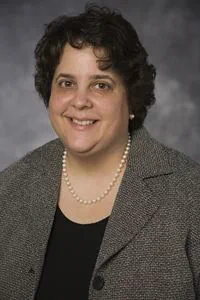Solutions for Spinal Muscular Atrophy
September 27, 2017

New program at UH Rainbow offers first-ever therapy for previously untreatable genetic disorder
Innovations in Pediatrics - Fall 2017
 Nancy Bass, MD
Nancy Bass, MD Jessica Goldstein, MD
Jessica Goldstein, MDPatients with the genetic condition spinal muscular atrophy (SMA) have access to a remarkable new treatment option through a new program at University Hospitals Rainbow Babies & Children’s Hospital – one of the only centers in the Midwest treating infants, children and adults with the condition.
The multidisciplinary program at UH Rainbow centers on administering the new medication Spinraza (nusinersen), approved by the U.S. Food and Drug Administration in late 2016 for use in patients with SMA.
“This has been a previously untreatable, sometimes fatal disease,” says pediatric neurologist Nancy Bass, MD, Program Director, Pediatric Neurology, UH Rainbow Babies & Children’s Hospital and Associate Professor of Pediatrics, Case Western Reserve University School of Medicine. “This has been a devastating diagnosis where there really has not been any hope for any type of improvement. But the children who have been treated here with Spinraza have already shown improvement in their strength. We have a 12-year-old who is swimmer, and she could do four laps. She’s had her third dose of Spinraza and can do 10 laps now. It’s a very exciting time for families that had no hope.”
Patients receiving Spinraza at UH Rainbow receive four loading doses, administered intrathecally. The first three doses are given two weeks apart; the last loading dose is given a month later. Maintenance doses are given every four months. Because patients with spinal muscular atrophy also often have scoliosis, sedation is often required for administering the drug.
“Sedating a child who has weakness of their breathing muscles four times is a big deal,” Dr. Bass says. “The respiratory piece is a big part of this, and that’s why it’s important to have a comprehensive program. Our program includes pediatric pulmonology and anesthesiology, as well as genetics, pediatric hematology and oncology, radiology and developmental pediatrics, among others. It’s a comprehensive program from start to finish.”
“Many centers have decided not to offer Spinraza because it is very time- and labor-intensive to get a program up and running,” Dr. Bass adds.
“It’s been a very concerted effort to offer it to our patients at UH Rainbow and University Hospitals in general.”
As it continues to serve more patients, the Spinal Muscular Atrophy Clinic and Treatment Program at UH Rainbow is documenting its experience – information it intends to share with other medical institutions.
For example, the early experience at UH Rainbow suggests that typical ideas about the radiation exposure of CT scans may need to be rethought.
“A lot of these patients have scoliosis, so getting a spinal tap is really difficult,” says pediatric neurologist Jessica Goldstein, MD, Co-Director of the UH Rainbow program and Assistant Professor of Pediatrics, Case Western Reserve University School of Medicine. “If you’re doing it four times and then every four months, people would shy away from a CT scan because that’s more radiation exposure. On the other hand, it takes just 30 seconds and the anatomy is so much clearer. We’ve sometimes opted for CT-guided. This is the time to be establishing best practices.”
The UH Rainbow team is also closely monitoring whether there appears to be an optimal treatment window for administering Spinraza.
“There is a study going on in babies who are pre-symptomatic, who are the siblings of babies who had SMA or who were identified with SMA in a newborn screen,” says Dr. Goldstein. “Some of these babies have attained developmental milestones they never should have attained – standing, walking – even though they are genetically a SMA type 1, the most severe form of the condition. Those findings are very compelling.
In our experience here so far, it does also seem that the infants tend to have more notable improvement.”
Because of this possible advantage of early treatment, both Dr. Bass and Dr. Goldstein encourage all pediatricians to quickly refer any infant with poor reflexes, poor feeding or low muscle tone.
“They just need to call,” Dr. Goldstein says. “We will get the child in to be seen.”
At the same time, Dr. Bass emphasizes that the SMA program at UH Rainbow treats patients of all ages.
“We have a comprehensive team dedicated to the care and treatment of these patients, whether they’re children or adults,” she says. “We’ve treated multiple children already and are seeing very positive results.”
For more information on the new Spinal Muscular Atrophy Clinic and Treatment Program at UH Rainbow or to refer a patient, please call 216-844-3691.


